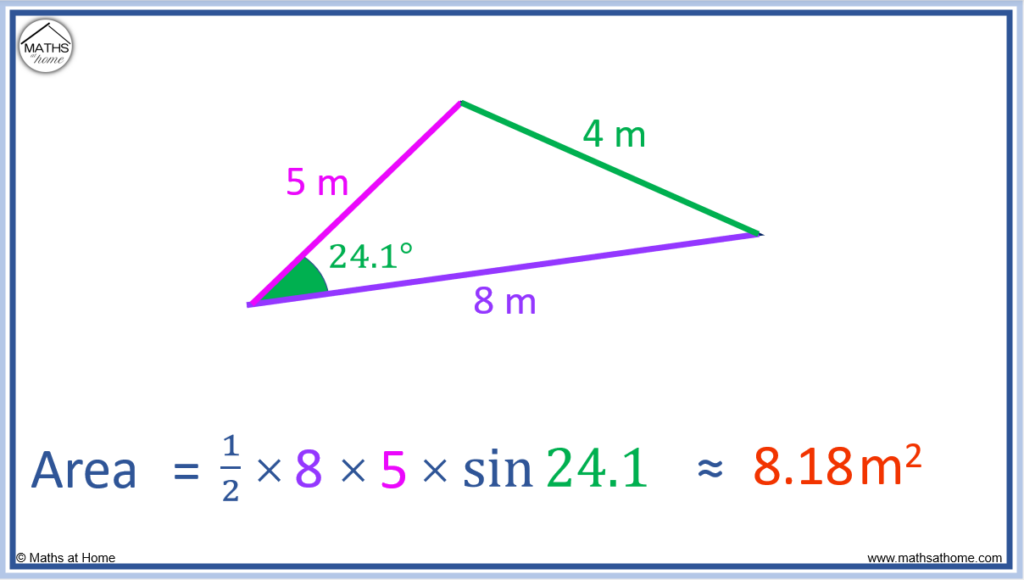Sine Rule for Area: Video Lesson
What is the Sine Rule for Area?
The sine rule for the area of a triangle is Area = ½ ab sinC, where ‘a‘ and ‘b‘ are two sides of a triangle and ‘C‘ is the angle in between them. The sine rule can be used to find the area of any triangle, even if the base and height are not known. At least 2 sides of the triangle and the angle between them must be known.
The Sine Rule for Area
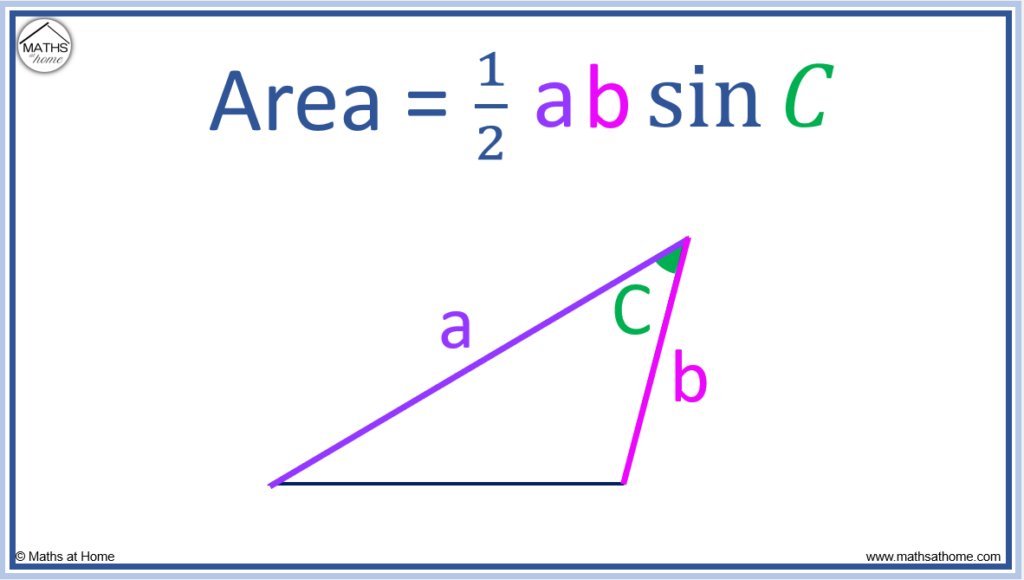
To use the sine rule for area, 2 side lengths must be known and the angle in between the two sides must be known.
When labelling the sides of a triangle, the lowercase letters: a, b and c are used for the sides. The uppercase letters: A, B and C are used for the angles.
- Angle A must be opposite the side length a.
- Angle B must be opposite the side length b.
- Angle C must be opposite the side length c.
In the sine rule for area, we only need sides ‘a‘, ‘b‘ and the angle ‘C‘ in between them.
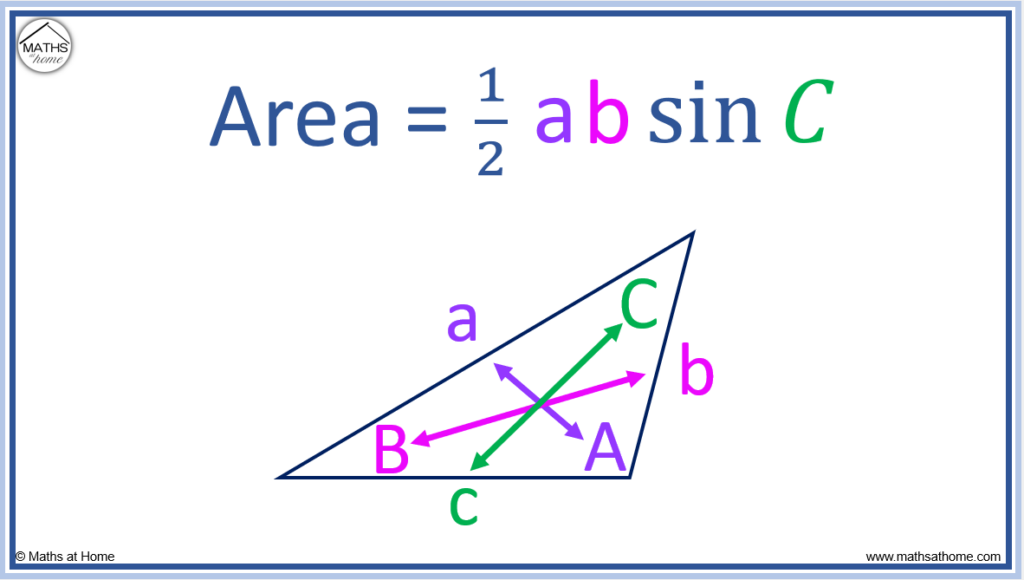
Example 1
Find the area of a triangle with side lengths 5 cm and 4 cm, with enclosed angle of 30°.
- ‘a’ = 5
- ‘b’ = 4
- ‘C’ = 30°
becomes
.
and therefore, the area of the triangle is 5 cm2.

Example 2
Find the area of a triangle with side lengths 5 m and 8 m.
The enclosed angle between these sides is unknown but the other two angles of the triangle are 100° and 45°.
The enclosed angle between the two known sides must be calculated first.
Angles in a triangle add to 180°.
The two known angles, 100° and 45° sum to 145°.
Therefore the enclosed angle is:
180° – 145° = 35°
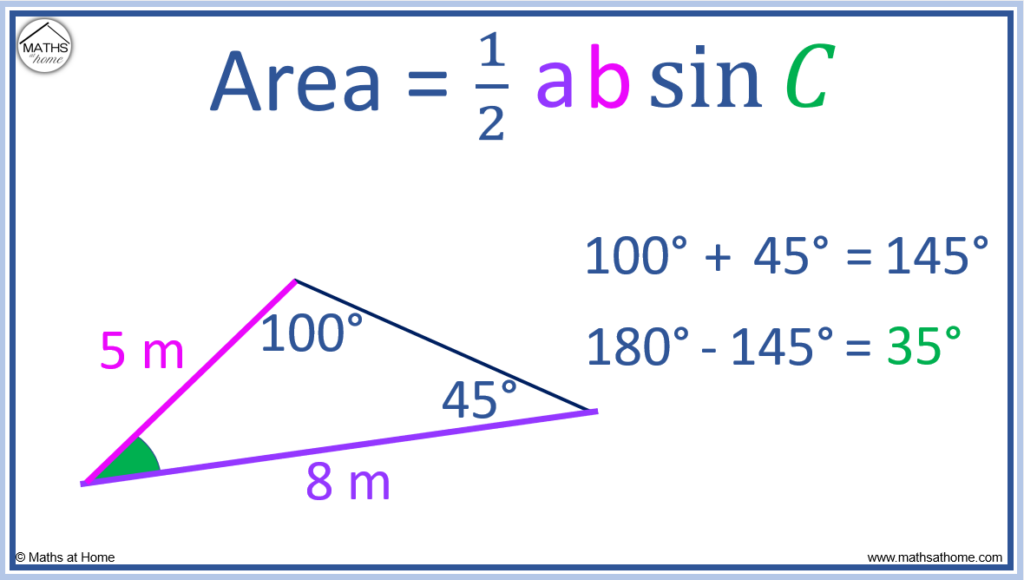
Now that the enclosed angle has been calculated, the sine rule can be used to calculate the area of the triangle.
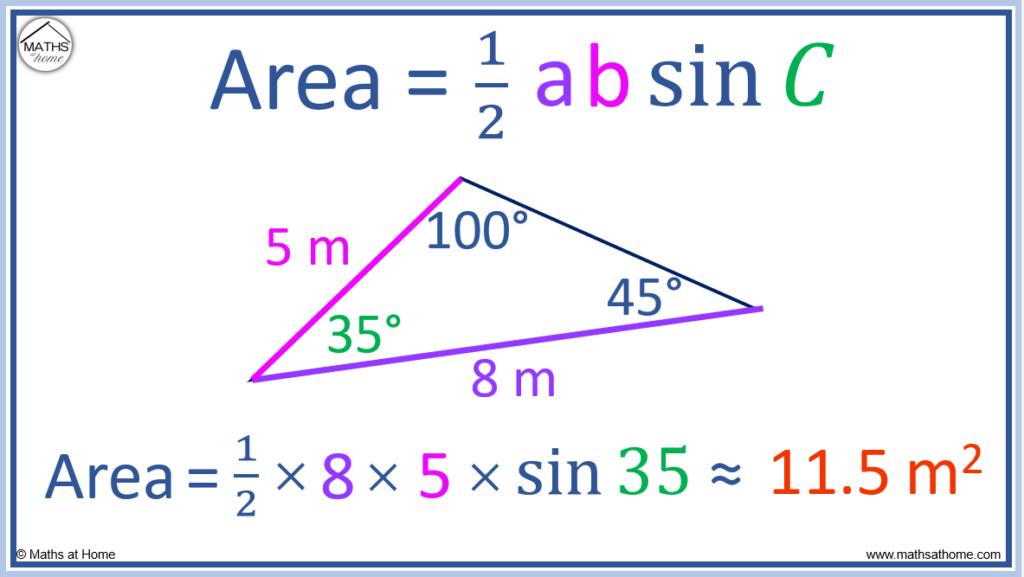
- ‘a’ = 8, ‘b’ = 5 and ‘C’ = 35°.
becomes
The area of the triangle is found to be approximately 11.5 m2.
How to Find the Area of a Triangle Using the Sine Rule
To find the area of a triangle using the sine rule:- Multiply two sides of the triangle together.
- Multiply this by the sine of the angle between the sides.
- Divide the result by 2.
Example
Find the area of the triangle with side lengths 3 cm and 7 cm. The angle between these sides is 70°.
1. Multiply the two sides of the triangle together
The two sides have lengths 3 cm and 7 cm. Multiplying these sides, 3 × 7 = 21.
2. Multiply this by the sine of the angle between the sides
The angle between the sides is 70°.
.
3. Divide the result by 2
and since the sides are measured in cm, the area of the triangle is approximately 9.87 cm2.
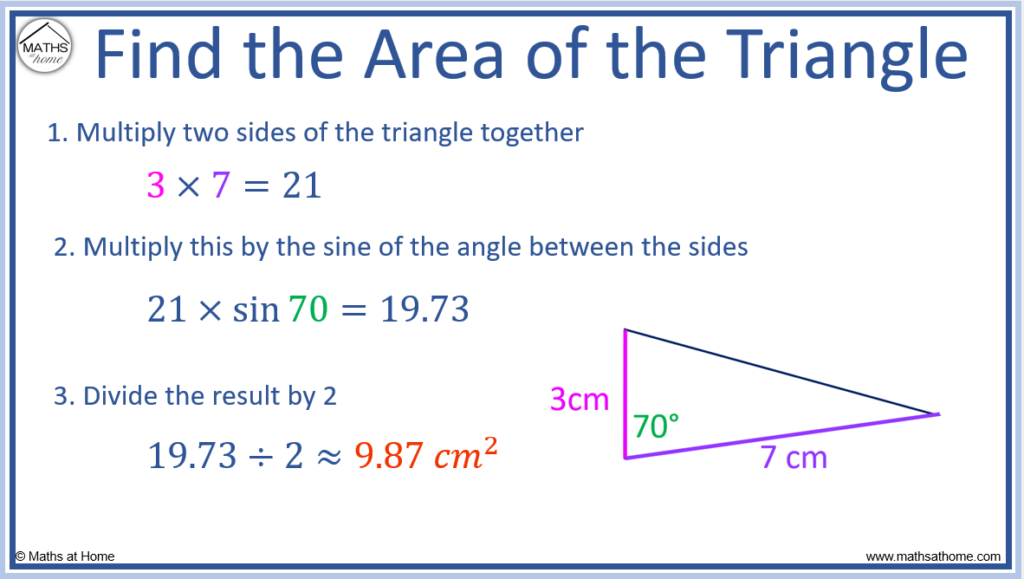
Sine Rule for Area Calculator
The sine rule area calculator is used to calculate the area of a triangle given any two sides of the triangle and an enclosed angle between them.
Side length ‘a’ is simply any side of the triangle.
Side length ‘b’ is any other side of the triangle.
Angle ‘C’ must be the angle in between these two sides.
Sine Rule for Area Proof
The sine rule for the area of a triangle can be derived using right-angled trigonometry. For a triangle with base ‘b‘ and an angle ‘C’ between the base and side ‘a‘, the perpendicular height is equal to ‘a sinC’. The area of a triangle is given by Area = ½×base×height. Substituting for height, the sine rule is obtained as Area = ½ ab sinC.
The proof of the sine rule can be shown more clearly using the following steps.
1. Consider a triangle with sides ‘a’ and ‘b’ with enclosed angle ‘C’.
The base of this triangle is side length ‘b’.
2. Consider the right-angled triangle formed from the height.
Using right-angled trigonometry, the height is equal to or
.
This is because the height is the opposite side to angle C and ‘a’ is the hypotenuse.
From trigonometry, ..
Substituting ,
and
, we obtain
.
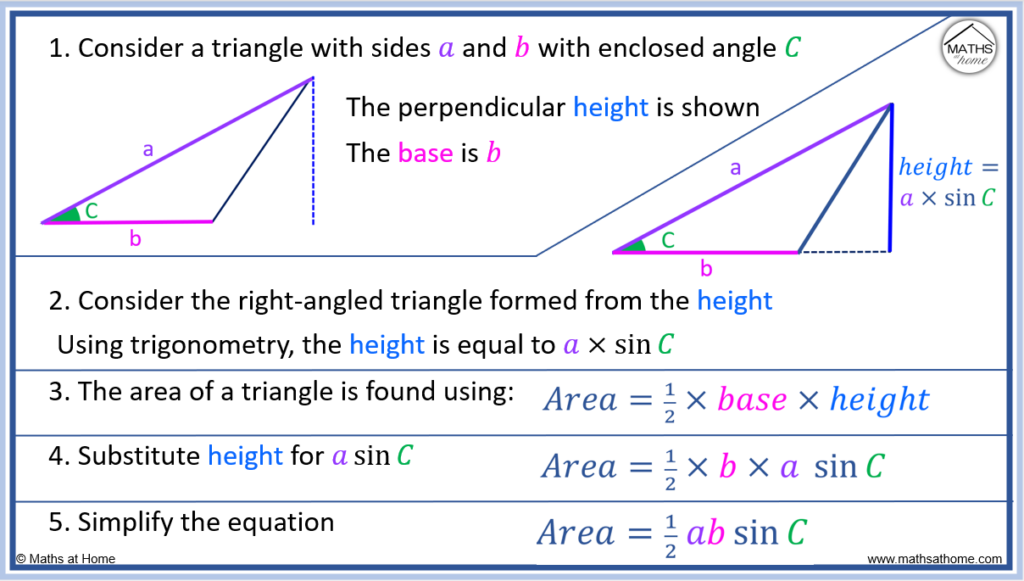
3. The area of a triangle is found using
4. Substitute height for
The base is equal to ‘b’ and the height is equal to ‘a sinC‘.
becomes
5. Simplify the equation
simplifies to the sine rule for area as we know it:
.
The sine rule for area works for any triangle, including non-right-angled triangles.
Finding the Area of a Triangle Using the Sine and Cosine Laws
To use the sine rule to find the area of a triangle, we must know two sides and the angle between them. Alternatively, if three sides are known the cosine rule can be used to find an angle first. If two sides and a non-enclosed angle are known, use the sine rule to find the enclosed angle.
In mathematics, the sine rule for the area of a triangle is .
This should not be confused with the general sine rule: which is used to calculate missing sides or angles rather than find the area of a triangle.
Example Involving the Sine Rule
In the example below, two sides are known as 4m and 8 m long.
The angle opposite the 8 m long side is 100°.
The sine rule can be used to find the angle C in the diagram below.
Writing the sine rule as , this can be rearranged to
.
Substituting the values of A = 100°, ‘c’ = 4 and ‘a’ = 8, .
Evaluating this, and so,
and therefore the angle is
.
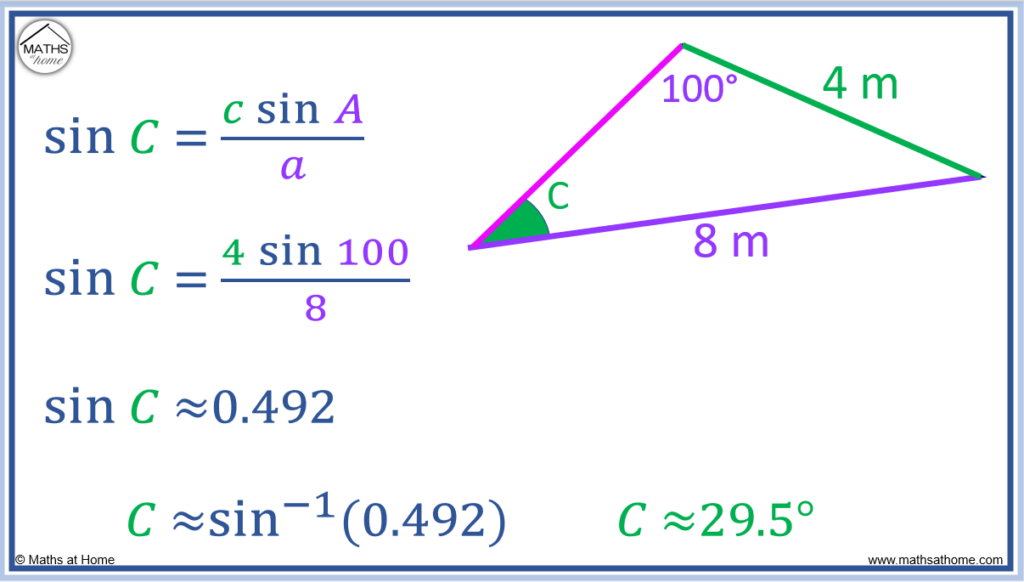
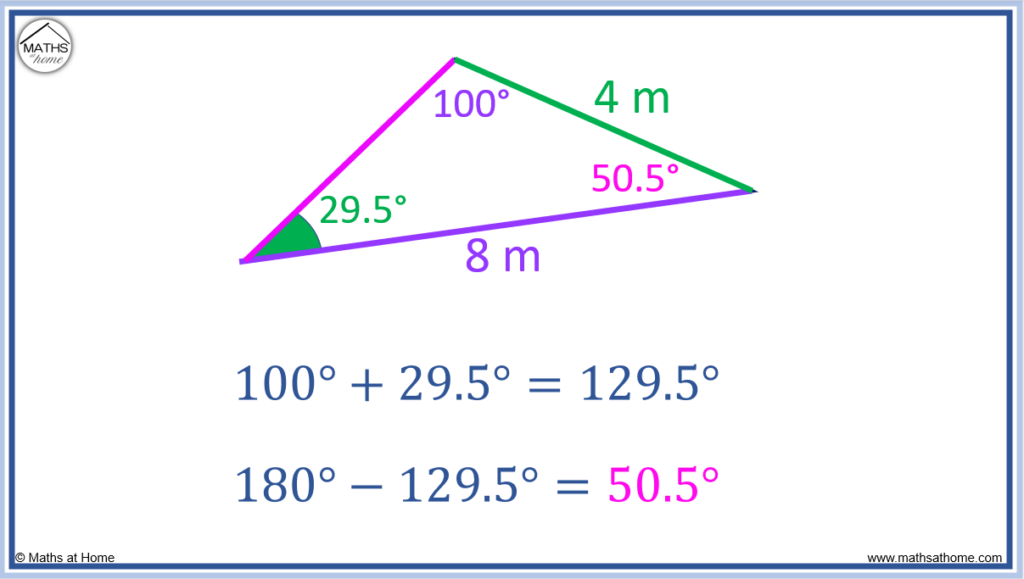
This angle is not enclosed by two known sides and so, the sine rule cannot be used just yet.
The third angle of the triangle must be found using the fact that angles in a triangle always sum to 180°.
180° – 100° – 29.5° = 50.5°. Therefore the missing third angle of the triangle is 50.5°.
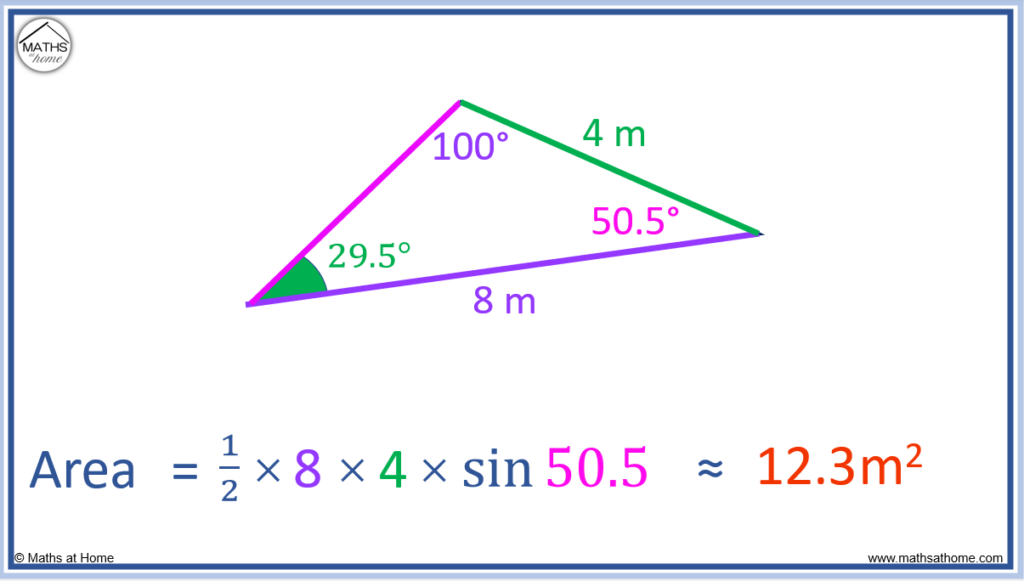
The sine rule for the area of a triangle can now be used.
‘a’ and ‘b’ are two known sides that encompass a known angle.
Therefore ‘a’ = 8, ‘b’ = 4 and C = 50.5°.
becomes
.
Evaluating this, .
Example Involving the Cosine Rule
In this example, all three side lengths are known as 5 m, 4m and 8m.
We need to know one of the angles between two of the sides. This has been labelled C in the diagram below.
Since this angle is C, the side opposite this must be labelled ‘c’. Therefore ‘c’ = 4.
‘a’ = 5 and ‘b’ = 8. It does not matter which way around these are labelled.
The cosine rule, can be rearranged for the angle C as
.
Substituting the values of ‘a’, ‘b’ and ‘c‘, this becomes: .
Evaluating this angle, .
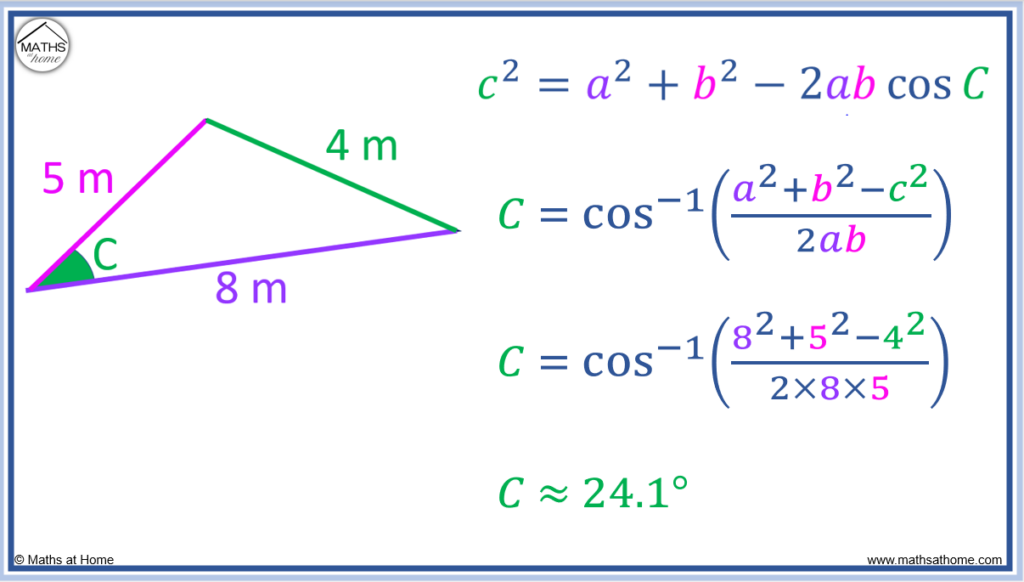
Now that an angle is known in between the two sides of length 5 m and 8 m, the sine rule for area can be used.
C = 24.1°, ‘a’ = 5 and ‘b’ = 8.
becomes
.
Evaluating this, .
